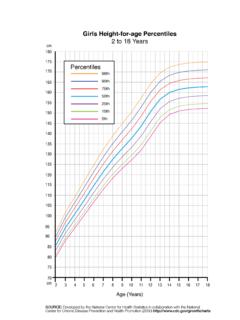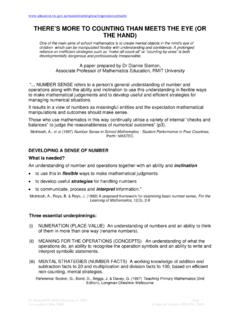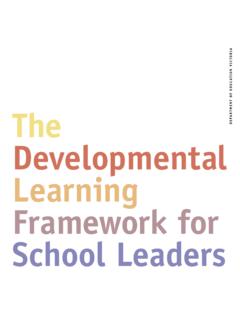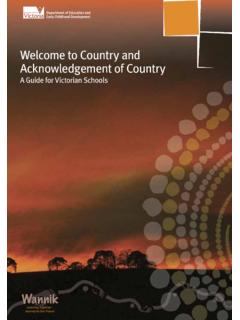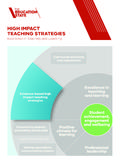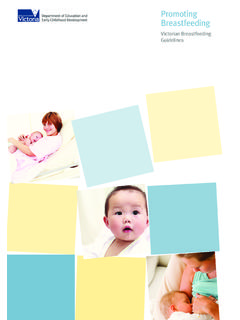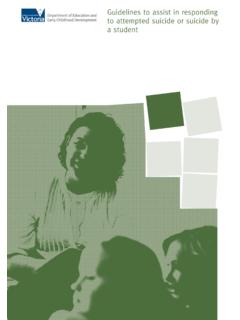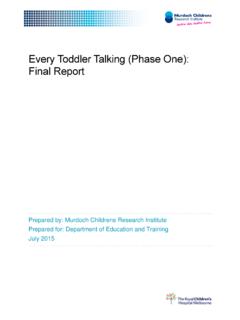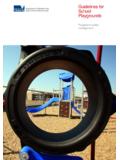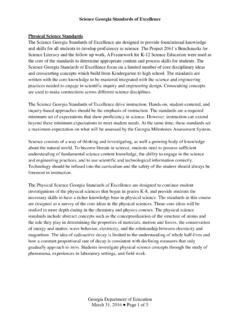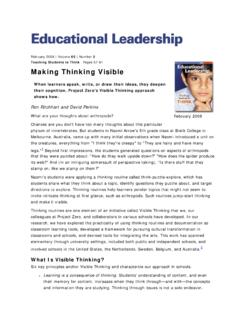Transcription of Practice Principle Guide 6Integrated Teaching and …
1 Victorian Early Years Learning and Development FrameworkPractice Principle Guide6 Integrated Teaching and Learning Approaches2 Written by Dr Anne Kennedy and Anne Stonehouse AM for the Early Childhood Policy and Strategic Projects Division, Department of Education and Early Childhood 2012 State of Victoria (Department of Education and Early Childhood Development) 2012 The copyright in this document is owned by the State of Victoria (Department of Education and Early Childhood Development), or in the case of some materials, by third parties (third party materials). No part may be reproduced by any process except in accordance with the provisions of the Copyright Act 1968, the National Education Access Licence for Schools (NEALS) or with educational institution situated in Australia which is not conducted for profit, or a body responsible for administering such an institution, may copy and communicate the materials, other than third party materials, for the educational purposes of the by the Department of Education and Early Childhood Development, 2 Treasury Place, East Melbourne, Victoria, document is available on the internet at this guide2 What is integrated Teaching and learning?
2 3 Why is integrated Teaching and learning important?6 How does integrated Teaching and learning look in Practice ?8 Action Plan21 References and resources222 About this guideThis Guide is one in a series of eight guides to the Practice principles in the Victorian Early Years Learning and Development Framework (VEYLDF, 2009).Use this Guide to support individual critical reflection on your Practice , for discussion with a mentor or critical friend and as a Guide for discussion with Guide draws on the Evidence Paper for Practice Principle 6: Integrated Teaching and Learning Approaches written for the Department of Education and Early Childhood Development by the University of Melbourne.
3 For detail about the evidence mentioned in this Guide , and for more depth on this Practice Principle refer to the evidence paper. 36 Integrated Teaching and Learning ApproachesWhat is integrated Teaching and learning?Early childhood professionals recognise that a gradual shift in emphasis occurs over the first eight years of a child s life, along a continuum from play to more structured learning in formal settings. Early childhood professionals apply strategies to support sustained and shared interactions with children through play to more focused is an active process that must involve children s engagement. Play is essential for its ability to stimulate and integrate a wide range of children s intellectual, physical, social and creative abilities.
4 Active engagement with, and attunement to children in their play extends and supports their learning. Shared, sustained conversations are also a powerful and important feature of active adult engagement. (VEYLDF, ). Integrated Teaching and learning approaches combine guided play and learning, adult-led learning, and child-directed play and learning. Integrated Teaching and learning involves the adult intentionally engaging with the child in play. The diagram above shows these three elements woven together, or integrated , because in the most effective learning environments, all three of these things happen. These elements are described briefly 1: Integrated Teaching and learning approaches (VEYDLF, p 12)What is play?
5 Play is central to the concept of integrated Teaching and learning. Through play, children learn to make sense of and construct ideas about the social and natural world the people, places, objects and experiences they encounter every are many definitions and descriptions of play and a variety of theoretical perspectives inform understandings of play and the approaches of early childhood professionals. Play is often described as child-directed, active, with a minimum of rules. This description is based on the notion of play as an exploratory process rather than a focused activity to achieve a particular learning outcome. A common misconception about play-based learning is that children choose what they will do and dictate the direction of the learning, with adults getting involved only when necessary in other words that play is always child-directed.
6 Current thinking however is that adults have a critically important role in children s play, even when the child directs it. 4 Discussion starter Before reading any further, jot down your definition of play. How does play promote learning? Adult-led learning occurs when adults introduce an experience or an idea, concept, topic for exploration and direct the learning by taking charge, giving instructions, setting rules, asking questions, and providing structure. Adult-led learning is about making judgments about what is worth children knowing by promoting worthwhile and challenging experiences and interactions that foster high-level thinking skills (Early Years Learning Framework, DEEWR, 2009, p.)
7 15). Children may have some control and input when adults lead the educator spoke about an adult-led learning experience. She teaches children in the year before starting school about road safety. She believes it is important for the children s safety and wellbeing as they become more independent. She teaches some aspects of road safety using direct instruction during group time, showing pictures and small versions of road signs and discussing their meaning. She teaches rules for crossing the road with words and modelled actions as well as by practising safe road crossing in the centre. She encourages families to teach the same rules using the same words and routines.
8 She also provides props such as vehicles, miniature road signs and traffic lights in the block and sand pit to encourage children to use and extend their knowledge. She also plans regular excursions with the assistance of the families, to allow children the opportunity to extend their learning that has developed over the project and encourage parent participation and play and learning occurs when children lead their learning through exploring, experimenting, investigating and being creative in ways that they initiate and control. The adult s role in child-directed play and learning may be to observe what the child knows and understands based on what they make, write, draw, say and do.
9 The adult can use that information to plan for further child brought in a basket of shells she had collected. She invited several other children to play with her in the sandpit building castles and decorating them with the shells. They found other natural materials such as small twigs and leaves, which they used also. The castle building became more and more elaborate as they generated new ideas for extending the castles and constructing stories about who lived in them. The children led the learning, which was provoked by the beautiful shells and a child s imagination. The educator listened, observed and identified learning occurring in the play including children s understandings about the size, shape and purpose of shells.
10 She decided to build on these concepts by using books about shells with the children to talk about different shapes and sizes as they used different ways to categorise the centre s shell collection. She made links with previous learning about snails and their Integrated Teaching and Learning ApproachesGuided play and learning occurs when adults are involved in children s play and learning, following children s interests and responding to spontaneous learning opportunities as they arise. The adult s role is to be intentional about planning for children s learning by making decisions about what is worth children knowing and a first-time parents group, a maternal and child health nurse encourages the parents to tune into their babies ways of playing so that they respond rather than take over.
